Promote files, news, pages, and navigational links to specific audiences on SharePoint with audience targeting. By enabling audience targeting, specific content is prioritized to specific audiences on the SharePoint start page, news on the mobile app, and in News web part when audience targeting is enabled.
Notes:
-
The following steps are for audience targeting in the modern experience. For the classic experience, follow the steps for SharePoint Server.
-
Azure Active Directory (Azure AD) groups (including security groups and Microsoft 365 groups) are supported. Azure AD dynamic groups are partially supported for some tenants.
-
You must be the site collection administrator to enable audience targeting for a library for the first time.
-
Publish (or republish) to save changes made to existing page content, page metadata, and audience targeting settings in order for audience targeting features to take effect.
-
If you've selected an audience group that you recently created or changed, it may take some time to see targeting applied for that group.
In this article:
-
Enable audience targeting for navigational links in menus
-
Enable audience targeting for a library
-
Enable audience targeting for a web part
Enable audience targeting for navigational links in menus
Important:
-
The site owner must enable audience targeting for site navigation. Once enabled, any site editor can target menu links to specific audiences.
-
Azure Active Directory (Azure AD) groups (including security groups and Microsoft 365 groups) are supported. Azure AD dynamic groups are partially supported for some tenants.
1. For the menu you want to add audience targeting properties to, select Edit.
-
For Teams sites, the edit option appears at the bottom of the left hand menu.
-
For communication and hub sites, the edit option appears to the right of the top menu.
2. At the bottom of the menu, turn on the toggle titled Enable site navigation audience targeting, and select Save. When enabled, audience targeting applies to all menus on the site, including hub and footer menus.
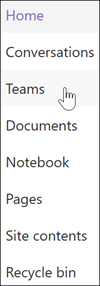
3. Next to the link that you want to edit, select the ellipses (...), and then select Edit.
4. In the entry box that appears, target up to 10 Microsoft 365 groups or security groups.
Important: When audience targeting is applied to a parent link, audience targeting also gets applied to the sub-links and is only be visible to the groups you specify.
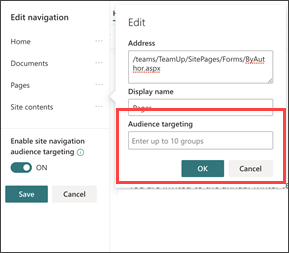
5. When you are done editing the link, select OK. An icon confirms the links are being targeted.
Note: While editing the navigation, all links and sub-links become visible to the editor, including those that are targeted. When saved, the navigation shows the targeted nodes.
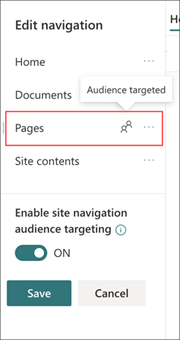
6. When done, select Save, or to discard changes, select Cancel.
Enable audience targeting for a library
Enable audience targeting in Library Settings:
-
Go to your library. For example, if you're working with pages or news, select Settings, select Site Contents, and then select Site Pages.
-
From the library, select Settings, and then select Library settings.
-
Under General Settings, select Audience targeting settings.
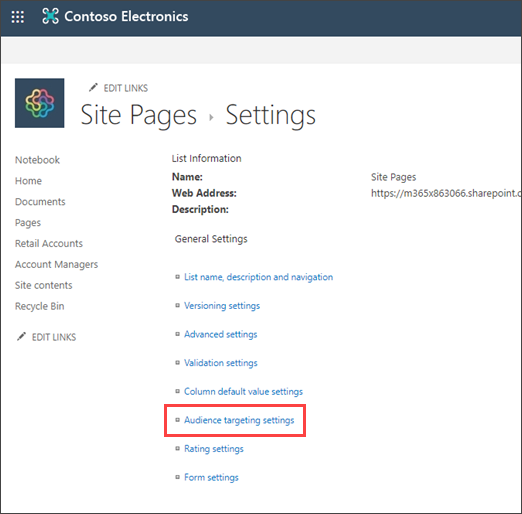
4. Select the Enable audience targeting checkbox, and then select OK. To return to the previous page, press the back button.
5. Select the audience. An audience is defined by Microsoft 365 and security groups. If you need to, create a Microsoft 365 group for the members of your audience. Or, if you're a SharePoint administrator, you can create a security group from the Microsoft 365 admin center.
6. From the library, select a file(s), and open the details pane.
7. In the details pane, select a value for the Audience property. Republish pages and update the news posts.
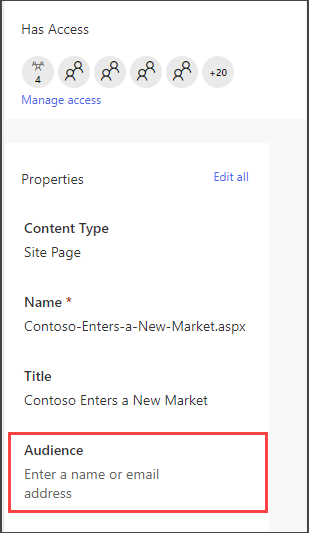
8. In Site Pages, confirm the right audiences are targeted to the right content.
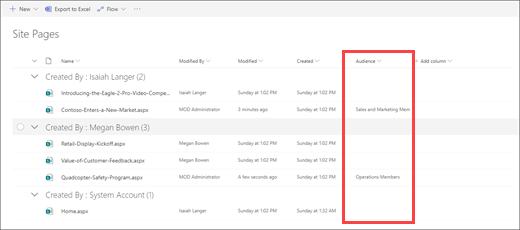
Enable audience targeting for a web part
The highlighted content web part and the news web part support audience targeting after it's enabled.
-
Edit an existing page or create a new one.
-
Add or Edit the highlighted content or news web part.
-
In the Filter section, turn on Enable audience targeting.
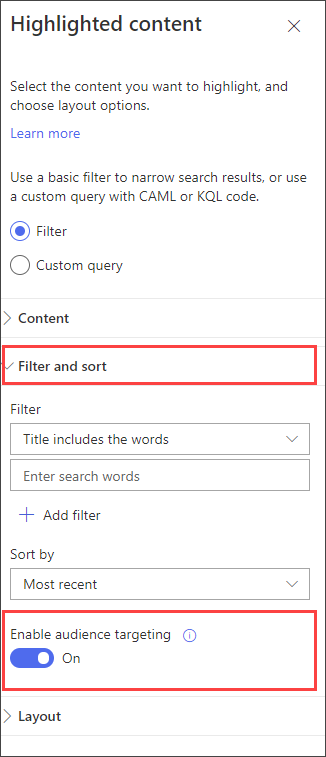
4. Publish or republish the page.
Overview
By using target audiences, you can display content such as list or library items, navigation links, and other content to specific groups of people. This is useful when you want to present information that is relevant only to a particular group of people. For example, you can add content to a document library that promoted to one department.
Any item in a SharePoint list or library can be targeted to specific audiences. To do this, you use the Content Query Web Part. Other types of Web Part and their content also can be targeted to audiences.
In addition, you can target site navigation links to audiences. Targeting the links simplifies the users' experience, because they see only the navigation links that are relevant to them.
To identify a target audience, you can use one or more of the following:
-
SharePoint groups
-
Distribution lists
-
Security groups
-
Global audiences
Global audiences are rules-based audiences that are maintained by SharePoint administrators.
Anyone with at least Contributor permissions can specify a target audience, as long as the name of the audience is known. To search for an audience by its name, alias, or description, in the Target Audiences list, select Browse  .
.
Target list or library items to an audience
The following procedure shows you an example about how to target all of the items from a specific list where the list type is a document library. The Content Query Web Part also allows you to show all of the items from a site and its sub-sites, or to show items from all sites in a site collection. You can then build a query to include the audience targeting that you set on the items in the sites or site collection.
Targeting items from a list or library to a specific audience requires three steps:
Step 1: Enable audience targeting on the list or library
When you enable audience targeting on a list or library, you can target each item in the list or library to an audience.
Note: If the SharePoint list or library already is enabled for audience targeting, the Target Audiences column appears.
-
For the item you want to target, select the list or library that contains.
-
For SharePoint or SharePoint Server 2019, select Settings, and then select List Settings or Document Library Settings.
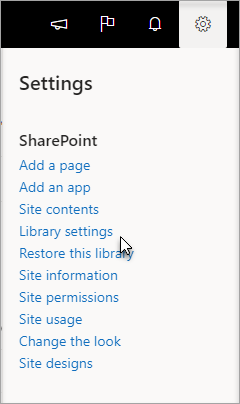 or
or 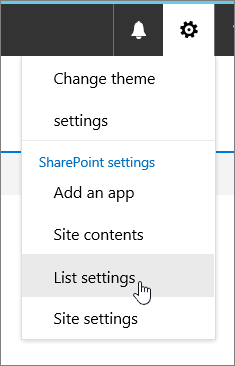
For SharePoint 2016, 2013, 2010, or 2007, on the list or library toolbar, select Settings, and then select List Settings or Document Library Settings.
 or
or 
-
Under General Settings, select Audience targeting settings.
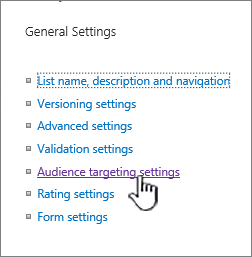
-
Select the Enable audience targeting checkbox.

Step 2: Specify the target audience on the items
After you enable the list or library for audience targeting, you can set individual items in the list or library to appear to one or more audiences.
-
For SharePoint or SharePoint Server 2019, to the left of the item you want to change audiences, select that area, select the details
 icon, and then select Edit All by properties.
icon, and then select Edit All by properties.For SharePoint 2016, 2013, 2010, and 2007, next to the name of an item in the list or library, select the arrow or ellipses (...), and then select Edit Properties or Properties. Some versions of SharePoint, you may need to select another set of ellipses (...).
-
In the Target Audiences list, add one or more audiences.

Note: If content approval or workflow is enabled on the list or library, the item may need to go through the approval process.
-
Select Save.
Step 3: Display the item in a Web Part for SharePoint 2016, 2013, 2010, or 2007
To display a SharePoint list or library item to a specific audience, you can use the Content Query Web Part. The Content Query Web Part allows you to build a query that can filter list and library items.
Note: For SharePoint, Web Parts may not be visible.
This example shows you how to display all of the items from a specific list to a target audience. The list type is document library.
-
On the page where you want to display the item, select
 or Settings
or Settings  , and then select Edit Page.
, and then select Edit Page. -
For SharePoint 2010, 2013, and 2016, select the Insert tab, and then select Web Part.

In SharePoint 2007, select Add a Web Part, and then under Default, select Content Query Web Part.
Under Content Rollup, select Content Query.

Note: If Content Query doesn't exist, check with your SharePoint admin.
-
Select Add.
-
For SharePoint 2010, 2013, and 2016, on the right of the web part, select the down arrow
 , and on the menu, select Edit Web Part.
, and on the menu, select Edit Web Part.In SharePoint 2007, select Edit, and to open the tool pane for the Web Part, select Modify Shared Web Part.
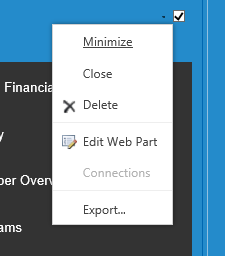
-
In the tool pane, under Query , do the following:
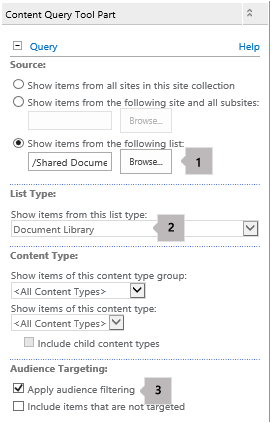
-
Select Show items from the following list, and then specify the location of the list.
Note: In this example, we specify a particular list. You can broaden the scope to include items in lists from more than one site by selecting one of the other options.
-
Under the required List Type, select the type of list that the item is a member of. In this example, select Document Library. Only items in the list type that you select are processed by the query.
-
Under Audience Targeting, do the following:
To
Do this
Display the list items to the target audience that you specified in Step 2: Specify the target audience on the items, when the current user is a member of the audience.
Select the Apply Audience Filtering checkbox. This is required for the query to work properly.
Display the items in the list that do not have a target audience specified. These items appear to everyone.
Select the Include items that are not targeted checkbox. This is optional.
When the page is rendered, the content in the web part appears only to current users who are members of the audiences you specified.
-
Target a Web Part to an audience
SharePoint web parts can be targeted to appear only to people who are members of a particular group or audience. This way you can create customized pages for specific groups.
Note: As with all Web Parts, the Content Query Web Part has a Target Audiences list in the Advanced section of the tool pane. This setting determines whether the Web Part itself is visible to the current user. If not, none of the other settings apply.
An audience can be identified by using a SharePoint group, a distribution list, a security group, or a global audience.
-
On the page where you want to display the item, select
 or Settings
or Settings  , and then select Edit Page.
, and then select Edit Page. -
For SharePoint 2010, 2013, and 2016, on the right of the web part, select the down arrow
 , and then select Edit Web Part.
, and then select Edit Web Part.
In SharePoint 2007, select Edit, and to open the tool pane for the web part, select Modify Shared Web Part.
-
Under Advanced, add one or more audience names to the Target Audiences list.
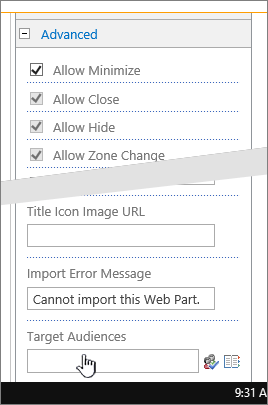
When the page is rendered, the web part appears only to the people who are members of the audiences you specified.
Target a navigation link to an audience
A navigation link on a SharePoint server can be targeted so that it appears only to people who are members of a particular group or audience. You need to have at least Design permission to modify the site navigation settings.
-
On the page where you want to display the item, select
 or select Settings
or select Settings  , and then select Site Settings. If you don't see Site settings, select Site information, and then select View all site settings.
, and then select Site Settings. If you don't see Site settings, select Site information, and then select View all site settings. -
Under Look and Feel, select Navigation, or select Modify Navigation.
-
Under Structural Navigation: Editing and sorting,on the Site Navigation Settings page, select Add Link.
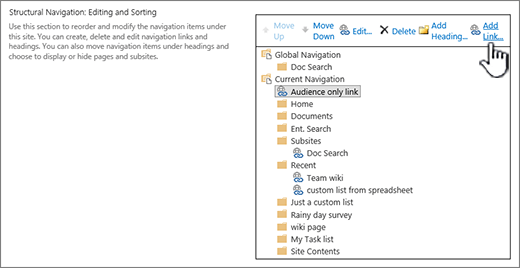
-
In the Navigation Link dialog, enter the Title and URL of the link, and then add one or more audience names to the Audiences list.
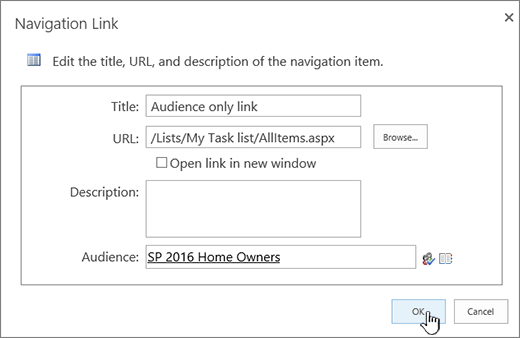
For the URL, you can copy one into the clipboard by right clicking the link, and then selecting Copy Shortcut. If you don't have that option in your browser, navigate to the page you want to link to, and copy the address bar.
When the page is rendered, the navigation link appears only to the people who are members of the audiences you specified.
No comments:
Post a Comment